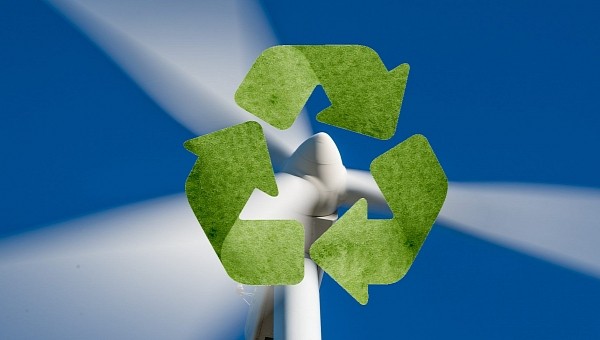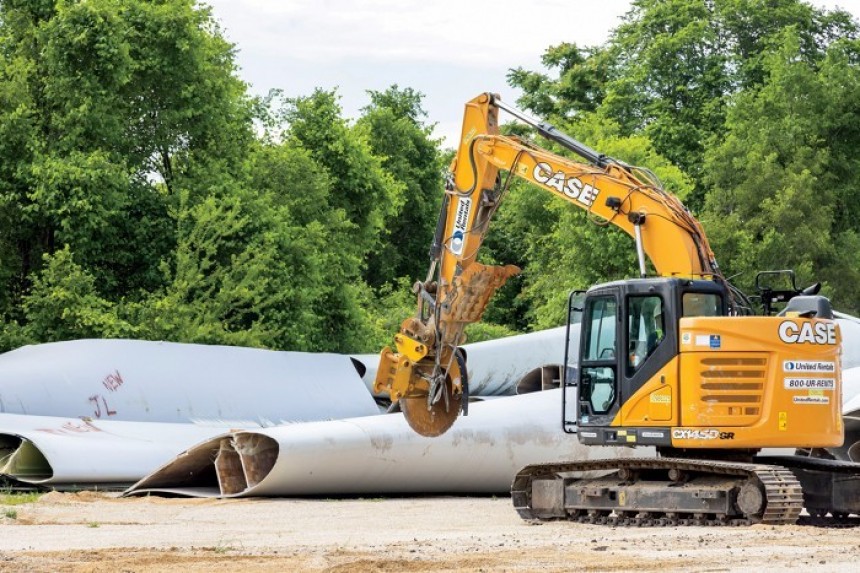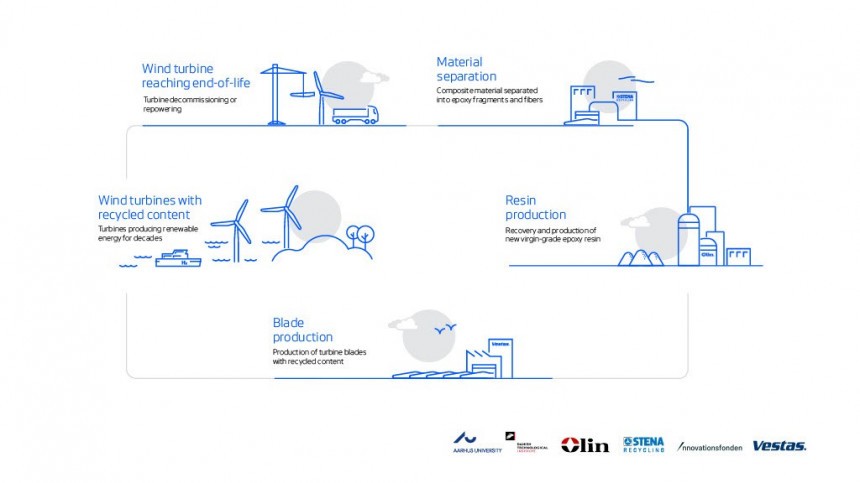A couple of years ago, headlines all over the world were pointing out that one of the symbols of the renewable energy revolution had “skeletons” in the ground. Literally. Namely, end-of-life blades from decommissioned wind turbines were piled up in landfills because they couldn’t be recycled. But this is not the case anymore because the wind industry has just found a solution to the issue.
Wind turbines have been with us for a couple of thousands of years. But they were used as grinding machines or to draw up water from the ground. At the end of the 19th century, the first electricity-generating wind turbine was supposedly installed by Scottish academic James Blyth.
But the real beginning of wind turbines used for generating electricity is the merit of American inventor Charles F. Brush. By the 1930s, wind generators for electricity were very common in U.S. farms, but then the oil revolution almost killed the wind turbine development. Sounds similar to the demise of EVs because of ICE cars, doesn't it?
Thanks to government subsidies and environmental activists’ lobbying, the wind industry was reborn in the early 1990s. So large-scale wind farms are not that old, but many wind turbines already reached their end-of-life and have been dismantled.
For instance, in the U.S. alone, around 8,000 blades were pulled down and landfilled in 2021. That’s because they are made from epoxy-based materials, fiberglass, and plastic resin. They are perfect for molding light and large blades, which can withstand harsh weather for more than 20 years. But apparently, recycling them was not an option.
And now, a recent study by NREL National Renewable Energy Laboratory shows that, by 2050, there will be more than 2 million tons of decommissioned blades in the U.S. Meanwhile, globally, there will be close to 50 million tons. While epoxy-based materials don’t pose environmental problems, getting rid of the blades is really a headache.
Just imagine that they are not made to be pulled apart, and usually, logistics for dismantling them from the turbines and transporting them to landfills is a real nightmare. Then, there is their composition: around 60-70% of the blade consists of reinforcing fibers and some carbon fiber. The rest is made out of balsa wood, metal foams, and a variety of protective coatings.
In order to be recyclable, the components of this strong mix must be separated. But, unlike thermoplastics, which melt when heated, the resin mixtures in blades simply burn when heated. This is a real issue because of the risk posed by an increasing number of wildfires due to climate change, and the blades in the landfills could have a negative impact on it.
In the last couple of years, Veolia came up with an interesting solution for the decommissioned blades. First, the blades are cut into smaller pieces for convenient transporting them to a processing center in Missouri. There, they are shredded into little pieces, and they can be blended with ingredients used for making cement.
Of course, it’s not the best solution because cement manufacturing is a major source of GHG emissions. Instead, Global Fiberglass Solutions is turning fiberglass blades into pellets used for industrial applications. But there’s a problem with cost efficiency, and it also implies using a lot of energy, which translates into big amounts of emissions.
The industry is working on different approaches to making recyclable blades from the design stage, but it's painful and costly because the trend is to make bigger blades, which require stronger mixtures that oppose the idea of easy disassembly at the end of life.
This is why Vestas’ recent announcement is not only seen as a breakthrough but also a big relief for all in the industry. They claim to have developed a novel chemical technology within the CETEC initiative – the acronym for Circular Economy for Thermosets Epoxy Composites – started just two years ago.
The details are very scarce for now, but Vestas and its partners apparently found a chemical recipe to break down epoxy resin into virgin-grade materials. This way, decommissioned blades can be turned into raw material to potentially build new turbine blades. It looks like the Holy Grail the industry hoped for.
But it looks like this process, after scaling it up, will really prove its efficiency, as it has the potential to encompass industries beyond wind energy. It’s interesting to know that the main partner of Vestas is Olin, “the No. 1 Global Manufacturer of Epoxy Products” and a leading U.S. manufacturer of ammunition.
One of the important branches of Olin’s epoxy business is related to the aerospace and automotive industry, but also to agricultural and construction machinery, and even marine and rail demands. It’s a long shot, but the new chemical process for epoxy resins could be the basis for new advances in light materials, cheaper than carbon fiber technology.
So it’s exciting news and all, but we are still some years away until the new technology will really be usable. The most important is the wind industry can go full steam ahead, as one of the major drawbacks is no longer an issue.
We can’t wait for the renewables detractors to find new and unexpected issues related to wind energy. It’s a real challenge, as wind turbines, especially offshore ones, are by far the most efficient way to produce clean energy up to this point. Well, mister former president, we expect something better than “these ugly windmills are ruining my ocean view” complaints.
But the real beginning of wind turbines used for generating electricity is the merit of American inventor Charles F. Brush. By the 1930s, wind generators for electricity were very common in U.S. farms, but then the oil revolution almost killed the wind turbine development. Sounds similar to the demise of EVs because of ICE cars, doesn't it?
Thanks to government subsidies and environmental activists’ lobbying, the wind industry was reborn in the early 1990s. So large-scale wind farms are not that old, but many wind turbines already reached their end-of-life and have been dismantled.
For instance, in the U.S. alone, around 8,000 blades were pulled down and landfilled in 2021. That’s because they are made from epoxy-based materials, fiberglass, and plastic resin. They are perfect for molding light and large blades, which can withstand harsh weather for more than 20 years. But apparently, recycling them was not an option.
Just imagine that they are not made to be pulled apart, and usually, logistics for dismantling them from the turbines and transporting them to landfills is a real nightmare. Then, there is their composition: around 60-70% of the blade consists of reinforcing fibers and some carbon fiber. The rest is made out of balsa wood, metal foams, and a variety of protective coatings.
In order to be recyclable, the components of this strong mix must be separated. But, unlike thermoplastics, which melt when heated, the resin mixtures in blades simply burn when heated. This is a real issue because of the risk posed by an increasing number of wildfires due to climate change, and the blades in the landfills could have a negative impact on it.
In the last couple of years, Veolia came up with an interesting solution for the decommissioned blades. First, the blades are cut into smaller pieces for convenient transporting them to a processing center in Missouri. There, they are shredded into little pieces, and they can be blended with ingredients used for making cement.
Of course, it’s not the best solution because cement manufacturing is a major source of GHG emissions. Instead, Global Fiberglass Solutions is turning fiberglass blades into pellets used for industrial applications. But there’s a problem with cost efficiency, and it also implies using a lot of energy, which translates into big amounts of emissions.
The industry is working on different approaches to making recyclable blades from the design stage, but it's painful and costly because the trend is to make bigger blades, which require stronger mixtures that oppose the idea of easy disassembly at the end of life.
The details are very scarce for now, but Vestas and its partners apparently found a chemical recipe to break down epoxy resin into virgin-grade materials. This way, decommissioned blades can be turned into raw material to potentially build new turbine blades. It looks like the Holy Grail the industry hoped for.
But it looks like this process, after scaling it up, will really prove its efficiency, as it has the potential to encompass industries beyond wind energy. It’s interesting to know that the main partner of Vestas is Olin, “the No. 1 Global Manufacturer of Epoxy Products” and a leading U.S. manufacturer of ammunition.
One of the important branches of Olin’s epoxy business is related to the aerospace and automotive industry, but also to agricultural and construction machinery, and even marine and rail demands. It’s a long shot, but the new chemical process for epoxy resins could be the basis for new advances in light materials, cheaper than carbon fiber technology.
So it’s exciting news and all, but we are still some years away until the new technology will really be usable. The most important is the wind industry can go full steam ahead, as one of the major drawbacks is no longer an issue.
We can’t wait for the renewables detractors to find new and unexpected issues related to wind energy. It’s a real challenge, as wind turbines, especially offshore ones, are by far the most efficient way to produce clean energy up to this point. Well, mister former president, we expect something better than “these ugly windmills are ruining my ocean view” complaints.








